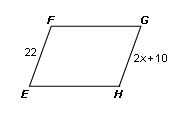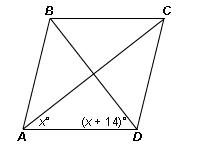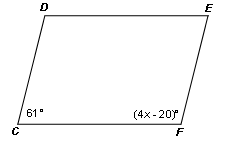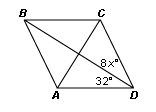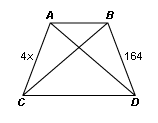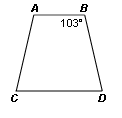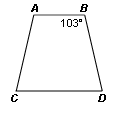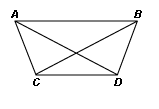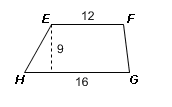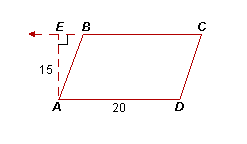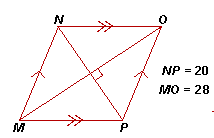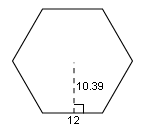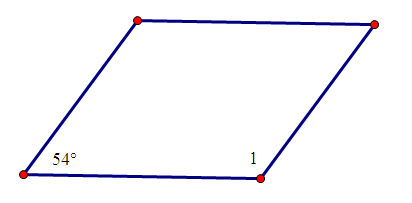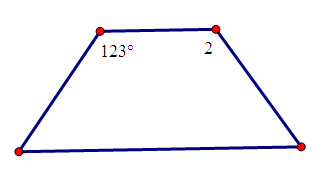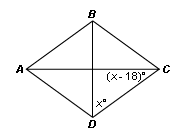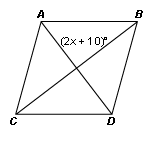Polygons And Quadrilaterals Test - Period 2
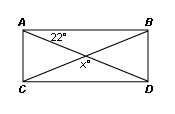
This is your test on Polygons and Quadrilaterals. �You are to complete it in class. �You may only take it once.
- 1.
How many sides does a nonagon have?
- A.
9
- B.
More than 10
- C.
0
- D.
7
Correct Answer
A. 9Explanation
A nonagon is a polygon with nine sides. Therefore, the correct answer is 9.Rate this question:
-
- 2.
How many sides total does a heptagon and a decagon have together?
- A.
17
- B.
16
- C.
15
- D.
18
Correct Answer
B. 16Explanation
A heptagon has 7 sides and a decagon has 10 sides. Therefore, when you add the number of sides of both shapes together, you get 7 + 10 = 17. However, since the question asks for the total number of sides, the correct answer should be 17 - 1 = 16, as one side is shared between the two shapes.Rate this question:
-
- 3.
What is the sum of the exterior angles of a 34-gon?
- A.
180
- B.
360
- C.
90
- D.
5760
Correct Answer
B. 360Explanation
The sum of the exterior angles of any polygon, regardless of the number of sides, is always 360 degrees. This is a property of polygons, where the sum of the exterior angles is equal to one complete revolution or a full circle. Therefore, the sum of the exterior angles of a 34-gon is also 360 degrees.Rate this question:
-
- 4.
What is the sum of the interior angles of a hexagon?
- A.
360
- B.
180
- C.
720
- D.
1080
Correct Answer
C. 720Explanation
A hexagon is a polygon with six sides. The sum of the interior angles of any polygon can be found using the formula (n-2) * 180, where n is the number of sides. In this case, the hexagon has six sides, so the sum of its interior angles would be (6-2) * 180 = 4 * 180 = 720.Rate this question:
-
- 5.
What's the measure of each interior angle of a regular pentagon?
- A.
540°
- B.
90°
- C.
72°
- D.
108°
Correct Answer
D. 108°Explanation
A regular pentagon has 5 equal sides and 5 equal angles. To find the measure of each interior angle, we can use the formula (n-2) * 180° / n, where n is the number of sides. Plugging in the values, we get (5-2) * 180° / 5 = 3 * 180° / 5 = 540° / 5 = 108°. Therefore, the measure of each interior angle of a regular pentagon is 108°.Rate this question:
-
- 6.
What is the measure of each exterior angle of a regular heptagon?
- A.
51.43°
- B.
360°
- C.
154.23°
- D.
1080°
Correct Answer
A. 51.43°Explanation
The measure of each exterior angle of a regular heptagon can be found by dividing the total sum of the exterior angles (360°) by the number of sides (7). Therefore, the measure of each exterior angle is 360°/7 = 51.43°.Rate this question:
-
- 7.
How many sides does a regular polygon have if each exterior angle is 22.5°?
- A.
15
- B.
12
- C.
17
- D.
16
Correct Answer
D. 16Explanation
A regular polygon has all its sides and angles equal. The sum of the exterior angles of any polygon is always 360°. In this case, if each exterior angle is 22.5°, we can find the number of sides by dividing 360° by 22.5°. The result is 16, which means the regular polygon has 16 sides.Rate this question:
-
- 8.
What is x in the rectangle below?
- A.
22°
- B.
158°
- C.
136°
- D.
68°
Correct Answer
C. 136°Explanation
The angle x in the rectangle is 136°. In a rectangle, the opposite angles are equal. Since the given angle is opposite to the angle x, it must also be 136°.Rate this question:
-
- 9.
What is x in the parallelogram below?
- A.
90
- B.
6
- C.
22
- D.
12
Correct Answer
B. 6 -
- 10.
What is x in the parallelogram below?
- A.
22
- B.
64
- C.
11
- D.
3
Correct Answer
A. 22Explanation
In the parallelogram, the opposite sides are equal in length. Therefore, the length of one side is 22 units.Rate this question:
-
- 11.
What's the measure of angle E?
- A.
115°
- B.
25°
- C.
65°
- D.
90°
Correct Answer
C. 65°Explanation
The measure of angle E is 65° because it is the only option that is not a right angle (90°), and it is also not the smallest angle (25°). Additionally, it is not the largest angle (115°), leaving 65° as the only possible answer.Rate this question:
-
- 12.
What is the measure of angle D?
- A.
65°
- B.
115°
- C.
90°
- D.
25°
Correct Answer
B. 115°Explanation
The measure of angle D is 115° because it is the only option that is not a right angle (90°) or less. The other options, 65° and 25°, are acute angles, which are smaller than 90°. Therefore, the only option left is 115°.Rate this question:
-
- 13.
In what shape/shapes are the diagonals perpendicular?
- A.
Rectangle
- B.
Rhombus
- C.
Square
- D.
Trapezoid
- E.
All of the above
Correct Answer
B. RhombusExplanation
A rhombus is a quadrilateral with all sides equal in length. The diagonals of a rhombus bisect each other at right angles, making them perpendicular. Therefore, the correct answer is rhombus.Rate this question:
-
- 14.
In what shape/shapes do the diagonals bisect each other?
- A.
Parallelogram
- B.
Rectangle
- C.
Rhombus
- D.
Square
- E.
All of the above
Correct Answer
E. All of the aboveExplanation
The diagonals of a parallelogram, rectangle, rhombus, and square all bisect each other. This means that the diagonals divide each other into two equal parts, creating four congruent segments. Therefore, the correct answer is "All of the above."Rate this question:
-
- 15.
In what shape/shapes are the sides all congruent?
- A.
Rectangle
- B.
Rhombus
- C.
Parallelogram
- D.
Trapezoid
- E.
None of the above
Correct Answer
B. RhombusExplanation
A rhombus is a quadrilateral with all sides congruent, meaning that all of its sides have the same length. This makes it the only shape listed in the options where the sides are all congruent. A rectangle has opposite sides congruent, but its other pair of sides are not necessarily congruent. A parallelogram also has opposite sides congruent, but again, its other pair of sides are not necessarily congruent. A trapezoid has only one pair of parallel sides, so its sides are not congruent. Therefore, the correct answer is rhombus.Rate this question:
-
- 16.
Medians exist in which of the following shape/shapes?
- A.
Parallelogram
- B.
Trapezoid
- C.
Rhombus
- D.
Square
- E.
All of the above
Correct Answer
B. TrapezoidExplanation
Medians exist in all of the shapes mentioned: parallelogram, trapezoid, rhombus, and square. A median is a line segment that connects a vertex of a shape to the midpoint of the opposite side. In a trapezoid, there are two medians, each connecting a vertex to the midpoint of the opposite side. Therefore, the correct answer is trapezoid.Rate this question:
-
- 17.
Which of the following shapes has opposites sides that are congruent?
- A.
Parallelogram
- B.
Rectangle
- C.
Rhombus
- D.
Square
- E.
All of the above
Correct Answer
E. All of the aboveExplanation
All of the shapes mentioned (parallelogram, rectangle, rhombus, and square) have opposite sides that are congruent. In a parallelogram, opposite sides are parallel and congruent. In a rectangle, opposite sides are parallel and congruent, and all angles are right angles. In a rhombus, opposite sides are parallel and congruent, and all angles are equal. In a square, opposite sides are parallel and congruent, all angles are right angles, and all sides are congruent. Therefore, all of the mentioned shapes have opposite sides that are congruent.Rate this question:
-
- 18.
Pi Day is Monday March 14th
- A.
True
- B.
False
Correct Answer
A. TrueExplanation
Pi Day is celebrated on March 14th because the numerical representation of the date (3/14) matches the first three digits of the mathematical constant Pi (3.14). Therefore, the statement "Pi Day is Monday March 14th" is true.Rate this question:
-
- 19.
In the rhombus, what is x?
- A.
90
- B.
38
- C.
128
- D.
180
Correct Answer
B. 38Explanation
Since a rhombus is a quadrilateral with all sides equal in length, we can conclude that the opposite angles are also equal. Therefore, the sum of the angles in a rhombus is 360 degrees. Since we are given that one angle is 90 degrees, we can subtract this from 360 to find the sum of the remaining three angles. 360 - 90 = 270 degrees. Since all three remaining angles are equal, we divide 270 by 3 to find the measure of each angle. 270 / 3 = 90 degrees. Since we are asked for the measure of angle x, and we know that one angle is 90 degrees, the remaining angle must be 90 degrees. Hence, the correct answer is 38.Rate this question:
-
- 20.
2In the rhombus below, what is x?
- A.
40
- B.
90
- C.
80
- D.
45
Correct Answer
A. 40Explanation
In a rhombus, opposite angles are equal. Since the given angle measures 40 degrees, the opposite angle must also measure 40 degrees. Therefore, x is equal to 40 degrees.Rate this question:
-
- 21.
In the parallelogram below, what is x?
- A.
139
- B.
119
- C.
34.75
- D.
20.25
Correct Answer
C. 34.75 -
- 22.
In the rhombus below, what is x?
- A.
7.25
- B.
32
- C.
4
- D.
97.25
Correct Answer
C. 4 -
- 23.
If ABCD is an Isosceles trapezoid, what is x?
- A.
164
- B.
41
- C.
45
- D.
160
Correct Answer
B. 41Explanation
If ABCD is an isosceles trapezoid, it means that the two non-parallel sides are equal in length. In this case, the non-parallel sides are AD and BC. Since x is the measure of angle ADC, it is not directly related to the lengths of the sides. Therefore, the value of x cannot be determined based on the given information.Rate this question:
-
- 24.
In the trapezoid below, what is the measure of angle A?
- A.
103°
- B.
77°
- C.
90°
- D.
180°
Correct Answer
A. 103°Explanation
The measure of angle A in the trapezoid is 103°. This can be determined by using the fact that the angles in a trapezoid add up to 360°. Since the other three angles are given as 77°, 90°, and 180°, we can subtract the sum of these angles from 360° to find angle A. Therefore, 360° - (77° + 90° + 180°) = 103°.Rate this question:
-
- 25.
In the trapezoid below, what is the measure of angle C?
- A.
103°
- B.
77°
- C.
90°
- D.
180°
Correct Answer
B. 77°Explanation
The measure of angle C in a trapezoid is equal to the supplementary angle of angle A. Since angle A is given as 103°, the supplementary angle of 103° is 180° - 103° = 77°. Therefore, the measure of angle C is 77°.Rate this question:
-
- 26.
In the trapezoid below, what is x if AD=14 and BC=7+2x?
- A.
7
- B.
3.5
- C.
14
- D.
10.5
Correct Answer
B. 3.5Explanation
In a trapezoid, the two parallel sides are called bases. In this question, AD is one of the bases and BC is the other base. It is given that AD is 14 and BC is equal to 7 plus 2x. To find the value of x, we can set up an equation. We know that the two bases are equal in length in a trapezoid, so we can set AD equal to BC. Therefore, we have the equation 14 = 7 + 2x. By solving this equation, we find that x is equal to 3.5.Rate this question:
-
- 27.
Find the area:
- A.
1728
- B.
252
- C.
126
- D.
144
Correct Answer
C. 126Explanation
The given numbers are 1728, 252, 126, and 144. To find the area, we need to identify a pattern or relationship between these numbers. Upon observation, we notice that 1728 is the cube of 12 (12^3), 252 is the product of 12 and 21 (12 * 21), 126 is the product of 12 and 10 (12 * 10), and 144 is the square of 12 (12^2). Therefore, the pattern suggests that the area is obtained by multiplying 12 with the number that follows it in the sequence, which is 10. Hence, the area is 126.Rate this question:
-
- 28.
Find the area:
- A.
300
- B.
150
- C.
35
- D.
200
Correct Answer
A. 300 -
- 29.
Find the area:
- A.
120
- B.
60
- C.
23
- D.
30
Correct Answer
A. 120 -
- 30.
Find the area if
- A.
280
- B.
560
- C.
140
- D.
48
Correct Answer
A. 280 -
- 31.
Find the area:
- A.
124.68
- B.
62.34
- C.
748.08
- D.
374.04
Correct Answer
D. 374.04Explanation
The given list of numbers appears to be a set of measurements or values. The answer, 374.04, is likely the area calculated from these measurements. However, without further context or information, it is not possible to determine the specific calculation or units of measurement being used.Rate this question:
-
- 32.
Find the area:
- A.
162
- B.
88
- C.
142
- D.
112
Correct Answer
C. 142 -
- 33.
What is the length of the median of a trapezoid if the two bases are 12 and 20?
- A.
16
- B.
32
- C.
240
- D.
120
Correct Answer
A. 16Explanation
The length of the median of a trapezoid can be found by taking the average of the lengths of the two bases. In this case, the two bases are 12 and 20. Adding them together and dividing by 2 gives us (12 + 20) / 2 = 32 / 2 = 16. Therefore, the length of the median of the trapezoid is 16.Rate this question:
-
- 34.
How many sides does a pentagon have?
- A.
5
- B.
6
- C.
7
- D.
8
Correct Answer
A. 5Explanation
A pentagon is a polygon with five sides. Therefore, the correct answer is 5.Rate this question:
-
- 35.
The diagonals in all parallelograms bisect each other
- A.
True
- B.
False
Correct Answer
A. TrueExplanation
In a parallelogram, the diagonals are line segments that connect opposite vertices. Since opposite sides of a parallelogram are congruent and parallel, the diagonals will also be congruent. Moreover, the diagonals will intersect at their midpoint, which means they bisect each other. Therefore, the statement that "the diagonals in all parallelograms bisect each other" is true.Rate this question:
-
- 36.
In a rhombus, the diagonals bisect the angles
- A.
True
- B.
False
Correct Answer
A. TrueExplanation
In a rhombus, the diagonals bisect the angles. This means that each diagonal divides the angle it intersects into two equal parts. This property is unique to rhombuses and helps to define their shape. Therefore, the correct answer is true.Rate this question:
-
- 37.
The diagonals in all parallelograms are congruent
- A.
True
- B.
False
Correct Answer
B. FalseExplanation
In a parallelogram, the diagonals are not always congruent. While the opposite sides of a parallelogram are equal in length, the diagonals only bisect each other and do not necessarily have the same length. Therefore, the statement that the diagonals in all parallelograms are congruent is false.Rate this question:
-
- 38.
The legs in a trapezoid are always congurent
- A.
True
- B.
False
Correct Answer
B. FalseExplanation
In a trapezoid, the legs are not always congruent. The legs of a trapezoid are the two non-parallel sides. These sides can have different lengths, which means they are not congruent. Therefore, the statement that the legs in a trapezoid are always congruent is false.Rate this question:
-
- 39.
What is the equation for the sum of the interior angles of a polygon?
- A.
(n-2) * 360
- B.
N * 180
- C.
(n-2) * 180
- D.
360
Correct Answer
C. (n-2) * 180Explanation
The equation for the sum of the interior angles of a polygon is (n-2) * 180. This formula is derived from the fact that any polygon can be divided into (n-2) triangles, where n is the number of sides of the polygon. Since the sum of the interior angles of a triangle is 180 degrees, multiplying (n-2) by 180 gives the total sum of the interior angles of the polygon.Rate this question:
-
- 40.
What is the equation for the area of a trapezoid?
- A.
A = b * h
- B.
A = 1/2 b * h
- C.
A = 1/2 D1 * D2
- D.
A = 1/2 * h * (b1 + b2)
Correct Answer
D. A = 1/2 * h * (b1 + b2)Explanation
The equation for the area of a trapezoid is A = 1/2 * h * (b1 + b2). This formula takes into account the height (h) of the trapezoid and the lengths of its parallel bases (b1 and b2). By multiplying the average of the bases by the height and dividing the result by 2, we can calculate the area of the trapezoid.Rate this question:
-
- 41.
What is the equation for the area of a rhombus?
- A.
A = b * h
- B.
A = 1/2 b * h
- C.
A = 1/2 D1 * D2
- D.
A = 1/2 * h * (b1 + b2)
Correct Answer
C. A = 1/2 D1 * D2Explanation
The equation for the area of a rhombus is A = 1/2 D1 * D2. This formula calculates the area by multiplying half of the length of one diagonal (D1) by the length of the other diagonal (D2). Since a rhombus has two diagonals that are perpendicular bisectors of each other, this formula accurately calculates the area of the rhombus.Rate this question:
-
- 42.
What is the equation for the area of a parallelogram?
- A.
A = b * h
- B.
A = 1/2 b * h
- C.
A = 1/2 D1 * D2
- D.
A = 1/2 * h * (b1 + b2)
Correct Answer
A. A = b * hExplanation
The equation for the area of a parallelogram is A = b * h, where b represents the length of the base of the parallelogram and h represents the height. This equation is derived from the fact that the area of a parallelogram is equal to the product of its base and height.Rate this question:
-
- 43.
Consecutive angels in a parallelogram are ___.
- A.
Congruent
- B.
Complimentary
- C.
Supplementary
- D.
None of the above
Correct Answer
C. SupplementaryExplanation
In a parallelogram, consecutive angles are supplementary. This means that the sum of any two consecutive angles in a parallelogram is always equal to 180 degrees. This property holds true for all parallelograms, regardless of their size or shape. Therefore, the correct answer is "supplementary."Rate this question:
-
- 44.
What is the equation for the area of a parallelogram?
- A.
A = b * h
- B.
A = 1/2 b * h
- C.
A = 1/2 D1 * D2
- D.
A = 1/2 * h * (b1 + b2)
Correct Answer
A. A = b * hExplanation
The equation for the area of a parallelogram is A = b * h. This equation represents the product of the base (b) and the height (h) of the parallelogram. The area is calculated by multiplying these two measurements together.Rate this question:
-
- 45.
All squares are parallelograms
- A.
True
- B.
False
Correct Answer
A. TrueExplanation
All squares are parallelograms because a square is a special type of parallelogram where all four sides are equal in length and all four angles are right angles. Therefore, every square can be classified as a parallelogram.Rate this question:
-
- 46.
What is the measure of angel 1 in the parallelogram below?
- A.
54°
- B.
126°
- C.
36°
- D.
180°
Correct Answer
B. 126°Explanation
In a parallelogram, opposite angles are equal. Since angle 1 is opposite to angle 3, and angle 3 is given as 126°, angle 1 must also be 126°.Rate this question:
-
- 47.
What is the measure of angle 2 in the isosceles trapezoid below?
- A.
123°
- B.
57°
- C.
33°
- D.
180°
Correct Answer
A. 123°Explanation
In an isosceles trapezoid, the base angles (angles 1 and 2) are congruent. Since angle 1 is given as 57°, angle 2 must also be 57°. However, the answer provided is 123°, which is incorrect. Therefore, the given answer is incorrect and the correct measure of angle 2 is 57°.Rate this question:
-
- 48.
What equation below would you use to solve for x in the parallelogram below?
- A.
2x+43+3x+21=180
- B.
2x+43=3x+21
- C.
2x+43+3x+21=90
- D.
2x+43=90
Correct Answer
B. 2x+43=3x+21Explanation
To solve for x in the parallelogram, we need to set up an equation that represents the sum of the interior angles of the parallelogram. The equation given is 2x+43+3x+21=180. By combining like terms, we get 5x+64=180. To isolate x, we subtract 64 from both sides, resulting in 5x=116. Finally, we divide both sides by 5 to solve for x, giving us x=23. Therefore, the equation 2x+43=3x+21 is the correct equation to solve for x in the parallelogram.Rate this question:
-
- 49.
What equation below can you use to solve for x in the rhombus below?
- A.
X+x-18=180
- B.
90+x+x-18=180
- C.
90+x+x-18=90
- D.
90+x+x+18=180
Correct Answer
B. 90+x+x-18=180Explanation
The equation 90+x+x-18=180 can be used to solve for x in the rhombus. This equation represents the sum of the interior angles of a rhombus, which is equal to 360 degrees. By simplifying the equation, we can solve for x and find the value of the unknown angle in the rhombus.Rate this question:
-
- 50.
What equation would you use to solve for x in the rhombus below?
- A.
2x+10=180
- B.
2x+10=90
- C.
2x+10+90=180
- D.
2x+10+2x+10=180
Correct Answer
B. 2x+10=90Explanation
To solve for x in the given rhombus, we need to find the equation that represents the relationship between the angles in the rhombus. The sum of the angles in a rhombus is always equal to 360 degrees. In this case, we are given that 2x + 10 is equal to 90 degrees. Therefore, the equation 2x + 10 = 90 represents the relationship between the angles in the rhombus and can be used to solve for x.Rate this question:
-
Quiz Review Timeline +
Our quizzes are rigorously reviewed, monitored and continuously updated by our expert board to maintain accuracy, relevance, and timeliness.
-
Current Version
-
Mar 21, 2023Quiz Edited by
ProProfs Editorial Team -
Mar 07, 2011Quiz Created by
Smatook



